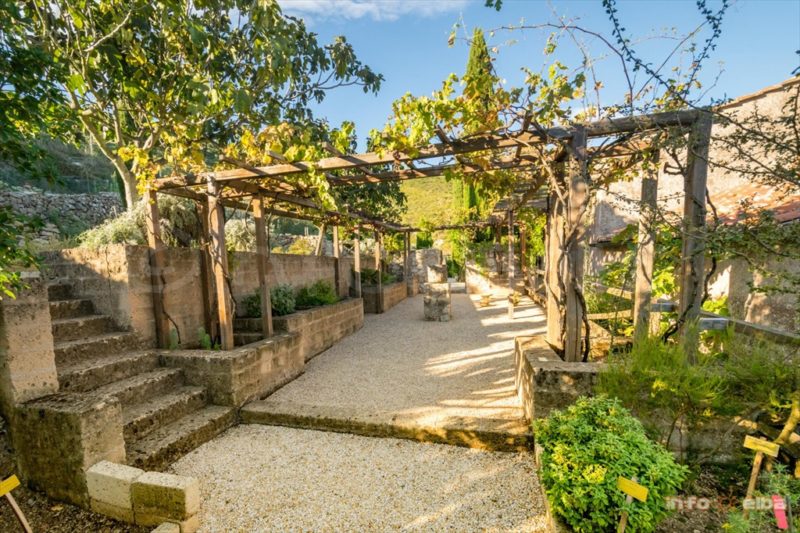
Orto dei Semplici Elbano
This post is also available in:
 Italiano (Italian)
Italiano (Italian)
This garden, covering more than 1.53 acres and annexed to the Hermitage of Santa Caterina in Rio nell’Elba, was born in 1990 thanks to G. Corsi and F. Garbari – its aim has always been to promote and circulate information about spontaneous and cultivated plants of the Tuscan Archipelago and to preserve their ethnobotanical traditions.
This facility also acts a powerful catalyst for new product initiatives in the agricultural and environmental fields, within the framework of economic and employment development – everything has always been done in complete harmony with the resources of the territory and the traditions of local communities.
The Garden has, therefore, assumed the role of a repository and an enhancement facility for the botanical species of naturalistic, pharmaceutical, agricultural, and forestry interest in the Tuscan Archipelago. Such an important role has been perfectly integrated with many institutional activities in this area, such as the protection of natural resources and island biodiversity.
All those vital activities have been possible thanks, first of all, to private initiatives (volunteers, and “Amici dell’Eremo Association”), the Municipality of Rio nell’Elba, and then the support of the Tuscany Region, the Province of Livorno, the Mountain Community, and the Archipelago National Park.
The scientific endeavor, relate to investigations on wild and cultivated plants, was handled by researchers of the Department of Botanical Sciences of the University of Pisa and the Scuola Superiore Sant’Anna of Pisa.
Spontaneous, exclusive, or rare (endemic) plants of different localities and typical environments of Elba have thus been properly identified, collected, and placed in specific plots (for example sea rocket, St. Peter’s grass, marram grass, and sea lily).
The garden is organized into 10 themed sections, while its very structure is mainly made of stone, tuff, and wood. The ten sections are: “the Mediterranean scrub”, “the pergola”, “the flora of the marine dunes”, “the sacred plants of ancient civilizations” – with symbolic plants such as laurel, pomegranate, common rue, dwarf palm and cypress – “the plants of the ancient Elban gardens”, “the labyrinth” (dedicated to the food plants that are still collected today by the population of Elba), “the amphitheater”, “the butterfly garden”, “the orchard”, and “the large field”.
At the entrance, the Mediterranean scrub sector is home to species used both in popular medicine and herbal medicine such as myrtle, lavender, rosemary and juniper.
In addition, the main cultivated fruit (plum, pear, peach, cherry, almond, grapevine, etc.) have been planted in a specific catalogued field – some of them threatened of extinction. There are also some ancient vines traditionally cultivated on Elba, such as Aleatico, Ansonica, Procanico and Alicante.
The Garden is part of a project funded by ARSIA (Regional Agency for Development and Innovation in the Agricultural and Forestry sector of the Tuscany Region). This organization promotes the recovery, conservation, and enhancement of the native germplasm.
The actual project presented to ARSIA was the result of mutual cooperation between the Sant’Anna School of Advanced Studies, the local Municipality, the Province of Tuscany, the local tourism promotion company, the Hermitage, and some local private firms. The main aim of this project is to take a census of the fruit heritage in the Elban territories, also providing thorough scientific investigation (pomological cards, ethnobotanicals, DNA analysis, nutraceuticals, etc.).
Thus, the botanical varieties with a deep-rooted historical, cultural, social or economic link with the territory will be registered in the Regional Repertoire.
A general framework and a computer database will also be provided to highlight the varieties most suitable for re-diffusion throughout the territory.
In addition, a proper “product basket” will be identified, to safeguard and promote the centuries-old popular tradition of island gastronomy through supply chains that will involve local entrepreneurs (farmers, food-processors, re-sellers, restaurants, etc.).
Recovering, characterizing, and re-spreading the old indigenous varieties does not represent an agricultural involution, but an inevitable step towards further ecological and environmental sustainability actions; this is also a serious commitment to niche products in the agri-food and tourism sector, which has already proved extremely rewarding especially in Tuscany.
Orto dei Semplici of the Hermitage of Santa Caterina will be able to further improve its educational role through the consolidation and constant improvement of its repertoire of fruit trees, promoting and investigating the agricultural and ethnobotanical heritage of the Archipelago. I will thus become also an official section of the “Banca del Germoplasma Toscano dell’ARSIA” (ASIA Tuscany Germoplasm Bank), as well as a vital catalyst for local and international tourism.
All this information were taken from the article “Orto dei Semplici of Elba, a living museum of plant species” by Agostino Stefani, Professor of Botany and Plant Biology at the S.Anna School of Advanced Studies of Pisa, published on “L’InformaRio”, issue 1, 2010.
Text and photo source:
https://www.infoelba.it/isola-d-elba/luoghi-da-visitare/musei/orto-dei-semplici/
This post is also available in:
 Italiano (Italian)
Italiano (Italian)
Contatti
Rio nell'Elba - Loc. Santa Caterina
0565 943428 / 339 2974678
ortodeisemplicielbano@gmail.com
